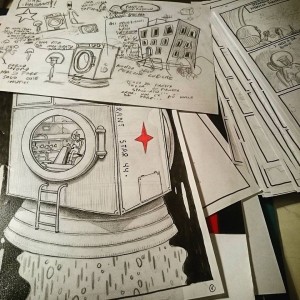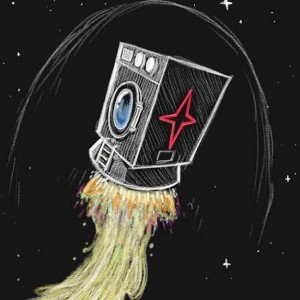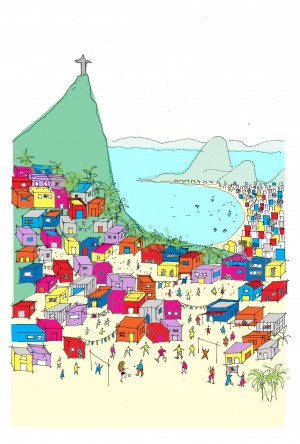For the Italian version, please, scroll down.
On June 23rd and 24th, at the Museum for Communication Berlin in in Leipziger Str. 16, the Comic Invasion Berlin will be on. Despite being a great book user, in particular of fiction, I have always looked at the illustrated fanzines or comics with little interest and curiosity, but since living in Berlin, a city very open to contemporary art expressions, I started to reevaluate and reconsider the beauty of these stories accompanied by images that, in some cases, are real tales of originality and creativity.
Federico Cacciapaglia, a very talented Italian cartoonist, explained to me how Berlin, which makes no distinction between series A and B‘ art, does not have the same snooty – probably because it doesn’t have the same artistic heritage – of other European capitals where, the value of every expression and form of art suffers from the inexorable comparison with the masterpieces of the Italian Renaissance as well as those of French Impressionism.
Even though Federico has always been passionate about drawing, he never thought that his passion can be transformed into a job. He always had a pencil in his hand because for him it was a need, it was his way of expressing himself since he was a child, but for a long time he did not have a project linked to his vocation. It was only during his time at University, when between one philosophy examination and another he decided to go to New York to study and learn the technique of drawing, that he realized he could live from his talent.
It was precisely after the American experience, in fact, that Federico decided to move to Berlin. The German capital, exactly why it was entirely reunited and rebuilt only recently, from different points of view, seemed to him a sort of European New York.
A city without the imposing, marvelous but cumbersome artistic legacy of Rome – its hometown – to contend with.
It was here in Berlin that Federico saw his first books published and where he started to participate successfully in festivals and shows dedicated to comics.
His first book, entitled Die Growls (2016), a thriller in which organic food fights against supermarket food, it was immediately followed by Mjam Mjam (2017), a book of Italian recipes accompanied by small comic stories in which the protagonists are the ingredients of the dishes.
His latest venture, Immigrant Star, is the story of a space immigrant looking for work in the universe. The immigrant Ziggy Star, accompanied by his unicorn friend called Bowie, is looking for his identity in a place that, a bit like Berlin, gathers many different cultures, a characteristic from which depend both the beauty of the place and the consequent relational and integration problems of those who move there depend upon.
For those wishing to take an unusual journey through the stories and characters born from the fervid Federico’s fantasy, as well as visit the Comic Invasion Berlin, they can just ‚float‘ in the fluctuating acquaspazio.net, blog inspired by the theories of the Liquid society by Bauman and those of the Sphere by Sloterdeijk, where all his creations are gathered.
The pleasure of giving life to things through a pencil
Another crucial meeting for the discovery of this genre in which, as Pratt said, „the descriptions, the expression of the faces and the settings are replaced by the drawings“, it was the one with Marta Di Ronco, a brilliant architect from Friuli, author of the images of the book Conto di Iemanja deusa do mar.
After graduating from the IUAV in Venice, Marta moved to Berlin, where she first worked with an international architecture firm and then with a German Hochbau und Stadtplanung (specialized in building construction and urban planning).
During one of our meetings, Marta told me that everyone has always appreciated her way of drawing so far as to entrust, thanks to her strong ability, the freehand realization of volumes and atmospheres to allow a clear visualization of projects to clients of the studies for which she worked.
But the pleasure of giving life to things through a pencil did not stop at the workplace. Progressively Marta began to reproduce the sidewalks and walls of Berlin, highlighting the cracks, which seem like scars on the skin, evidence of the past, signs of life which runs through it, fragments of memory of the city.
Always through his drawings, she then began to talk about Brazil and its culture. Inspired by her travels and by the Maracatù music, which she plays every week with a group of percussionists, Marta has made t-shirts with African-Brazilian themes and the logo that identifies the band she belongs to.
Another her collection is dedicated to the body of the woman, whose beauty she wanted to exalt in an absolutely personal way. This is how the vulva was born, which becomes a scale without end, or the underwear from which come out little flowers rather than pubic hair, or the breasts that become roads, landscapes, paths.
Until she got to her first comic.
Together with Luis Pedro Vitorino, who wrote the text, Marta illustrated a story inspired by the orixas, the divinity of Afro-Brazilian culture. Marta tried to respect its essence and to represent the story in a simple and sincere way.
The result is Conto di Iemanja deusa do mar, which narrates the adventure on the land of Iemanja, the goddess of the sea, who fights against envy and prejudice.
Exhibition of her works are on at:
–
Caffeggiando (Anzengruberstraße 19, 12043 Berlin)
;
– Aviatrix Cafe Atelier (Herrfurthstraße 13, 12049 Berlin), where she also holds design workshops for children.
Italian version
Il 23 e 24 giugno, presso il Museo per la Comunicazione in Leipziger Str. 16, si terrà il Comic Invasion Berlin.
Pur essendo un grande usufruitore di libri, in particolare di narrativa, ho sempre guardato con scarso interesse e poca curiosità le fanzine illustrate o i fumetti, ma da quando vivo a Berlino, città molto aperta alle espressioni d’arte contemporanea, ho iniziato a rivalutare e a riconsiderare la bellezza di queste storie accompagnate da immagini che, in alcuni casi, sono dei racconti ben strutturati, originali e creativi.
Federico Cacciapaglia, bravissimo fumettista italiano, mi ha spiegato di come Berlino, che non fa distinzione tra arte di serie A e di serie B, non abbia la stessa spocchia – probabilmente anche perché non ha lo stesso patrimonio artistico – di altre capitali europee in cui, il valore di ogni espressione e forma d’arte soffre dell’inesorabile confronto con i capolavori del rinascimento italiano o dell’impressionismo francese.
Federico, pur disegnando da sempre, non aveva mai pensato che quella sua passione potesse trasformarsi in un lavoro.
Aveva sempre la matita in mano per una reale esigenza, era il suo modo di esprimersi sin da quando era piccolo, anche se, per molto tempo, non ha avuto alcuna progettualità legata alla sua vocazione. È stato soltanto durante gli anni universitari, quando – tra un esame di filosofia e l’altro – andò a New York per studiare e imparare la tecnica del disegno, che Federico realizzò di poter vivere del suo talento.
Fu proprio in seguito all’esperienza americana, infatti, che maturò la decisione di trasferirsi a Berlino. La capitale tedesca, proprio perché interamente riunificata e ricostruita solo di recente, sotto diversi punti di vista gli sembrava una sorta di New York europea. Una città senza la imponente, meravigliosa ma ingombrante eredità artistica di Roma – sua città natale – con cui fare i conti.
Ed è stato qui a Berlino che Federico ha visto pubblicati i suoi primi libri e ha iniziato a partecipare con successo a festival e a rassegne dedicate ai fumetti.
Al libro d’esordio dal titolo Die Growls (2016), un thriller in cui il cibo biologico combatte contro il cibo del supermercato, è subito seguito Mjam Mjam (2017), libro di ricette italiane accompagnate da piccole storie a fumetti in cui i protagonisti sono gli ingredienti delle pietanze.
La sua ultima impresa, Immigrant Star, è la storia di un immigrato spaziale alla ricerca di lavoro nell’universo.
L’immigrato Ziggy Star, accompagnato dal suo amico unicorno Bowie, è alla ricerca della sua identità in un luogo che, un po’ come Berlino, raccoglie tante culture diverse, caratteristica da cui dipendono sia la bellezza del luogo che i conseguenti problemi relazionali e di integrazione di chi vi si trasferisce.
Per chi volesse compiere un insolito viaggio attraverso le storie e i personaggi nati dalla fervida fantasia di Federico, oltre che visitare il Comic Invasion Berlin, basterà ‘galleggiare’ nel fluttuante acquaspazio.net, blog ispirato alle teorie della Società liquida di Bauman e a quelle della Sfera di Sloterdeijk, dove confluiscono tutte le sue creazioni.
Il piacere di dar vita alle cose attraverso una matita
Altro incontro determinante per la scoperta di questo genere in cui, come diceva Pratt, “le descrizioni, l’espressione dei volti e le ambientazioni sono sostituite dai disegni”, è stato quello con Marta Di Ronco, un brillante architetto friulano, autrice delle immagini del libro Conto di Iemanja deusa do mar.
Conseguita la laurea presso lo IUAV di Venezia, Marta si è trasferita a Berlino dove ha prima collaborato con uno studio di architettura internazionale e poi con uno studio tedesco specializzato in costruzioni di edifici e pianificazione urbana – Hochbau und Stadtplanung.
Durante un nostro incontro, Marta mi ha raccontato che tutti hanno sempre apprezzato il suo modo di disegnare tanto che, grazie a questa sua spiccata capacità, le hanno spesso affidato la realizzazione a mano libera di volumetrie e atmosfere per consentire una chiara visualizzazione dei progetti ai clienti degli studi per i quali ha prestato la sua opera.
Ma il piacere di dar vita alle cose attraverso una matita, non si è fermato all’ambito lavorativo. Progressivamente Marta ha iniziato a riprodurre i marciapiedi e i muri di Berlino mettendone in risalto le crepe, che sembrano cicatrici sulla pelle, testimonianze del passato, segni della vita che l’attraversano, frammenti di memoria della città.
Sempre attraverso i suoi disegni, ha poi iniziato a raccontare del Brasile e della sua cultura. Ispirata dai suoi viaggi e dalla musica Maracatù, che suona ogni settimana con un gruppo di percussionisti, Marta ha anche realizzato delle magliette con temi afro-brasiliani nonché il logo che identifica la banda di cui fa parte.
Altra collezione di cui è autrice è quella dedicata al corpo della donna, di cui ha voluto esaltare la bellezza in modo assolutamente personale. È così che è nata la vulva che diventa una scala senza fine, la biancheria intima da cui fuoriescono fiorellini piuttosto che peli pubici, seni che diventano strade, paesaggi, percorsi.
Disegno dopo disegno, anche per lei si è presentata l’occasione di cimentarsi con un comic. Insieme a Luis Pedro Vitorino, che ne ha curato il testo, Marta ha illustrato un racconto ispirato agli orixa, divinità della cultura afro-brasiliana. Nel dar vita ai personaggi e ai luoghi della storia, Marta ha tentato di rispettarne l’essenza e di rappresentare ogni cosa in modo semplice e sincero. Il risultato è il libro Conto di Iemanja deusa do mar che narra l’avventura sulla terra di Iemanja, la dea del mare, che combatte contro l’invidia e i pregiudizi.
I suoi lavori sono attualmente esposti presso:
– Caffeggiando (Anzengruberstraße 19, 12043 Berlin),
– Aviatrix Cafe Atelier (Herrfurthstraße 13, 12049 Berlin), dove tiene anche workshop di disegno per bambini.































